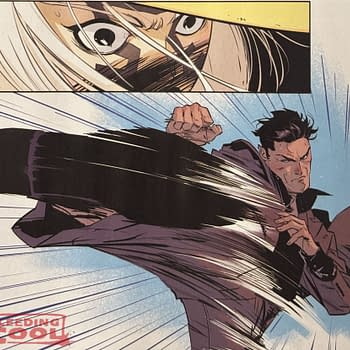Posted in: Comics, Review | Tagged: Adam Withers, amanda conner, bill willingham, Comfort Love, Complete Guide to Self-Publishing, Danielle Corsetto, David Peterson, Jeremy Bastian, Jill Thompson, Jim Demonakos, jimmy palmiotti, katie cook, mark waid, michael avon oeming, scott kurtz, steve geppi, Steve Sunu, terry moore
A Complete Guide To Self-Publishing Comics: Comfort Love And Adam Withers Talk Shop, Plus Review
By Michele Brittany, West Coast Bleeding Cool Correspondent
I met Comfort Love and Adam Withers by accident last summer at Anime Expo when I was early to a panel and consequently caught part of the panel they were leading. I was bummed I had not been there for their entire panel. Fortunately, they were leading another panel later that weekend, and I made a point of attending. What drew me in was their approach to teaching was straightforward, honest and positive. They were engaging and humorous yet able to stay on task and present concepts in bite size morsels so the audience could follow along. And, it is the same approach they take with this book, The Complete Guide to Self-Publishing Comics: How to Create and Sell Comic Books, Manga, and Webcomics (2015, Watson-Guptill Publications). Below, I include my thoughts and review of their book as well as an interview I conducted with Love and Withers.

* Michael Avon Oeming (The Victories, Powers)
* Bill Willingham (Fables, Angel)
* Terry Moore (Strangers in Paradise, Echo)
* Mark Waid (Daredevil, Kingdom Come)
* Jim Demonakos (Emerald City Comicon Director)
* Steve Sunu (Editor, Comic Book Resources Reviews)
* Steve Geppi (President/CEO of Diamond Comic Distributor)

Who is the book for? Comfort and Adam use the term "comics" to encompass comics, manga and webcomics. Obviously, if you are thinking and researching the self-publishing route, this book is for you. If you are a writer or artist, then this book will give you insight into each role, since most creative individuals are one or the other, and how to go about finding your counterpart. However, when it comes to coloring and lettering, Comfort and Adam deviate and dig into the step-by-step process of color and lettering via Adobe Photoshop and Illustrator respectively. These sections are particularly helpful for the individual who cannot afford to hire someone and must do it themselves. The flip side: the in depth steps assist individuals who may be looking to get into coloring and/or lettering but didn't know how or where to start.

The language level and tone is clear and concise. As far as I could tell during my read through, the text was free of errors. The three-page index is comprehensive without feeling like it was micro-managed. The design and presentation of material is clean and colorful. Comfort and Adam are consistent in the look of the sub-sections each time. They use a lot of examples from their own work, always taking care that it matches up with their point and not just fluff. The book is a decent size and thickness. The book is printed on sturdy paper that will hold up to a lot of use. And, the covers – front and back – are engaging and fun.

I know this is a book I will reference again and again – it will be one of my "go to" books on comics. Personally, I think Comfort and Adam's Complete Guide to Self-Publishing Comics should be required reading for anyone contemplating self-publishing. At the very least, this book should be strongly recommended reading for understanding the mechanics of comics from inception to hand.

Michele Brittany: How long have you been working together as a creative team? Do you both share the writing and illustrating duties in your comics?
Comfort Love: We met and started dating in 2000 when we were 19 and sophomores in art school. Since making and reviewing art was pretty much all we did in school, we were helping each other learn and grow right from the start. Sooo…it'll be 15 years this October that we've been a team.
Adam Withers: And we share in everything on our comics. We write together, we draw together, we color and letter together, and we run the business of getting all these things self-published together.
CL: It's really more symbiosis than collaboration. We're the two-headed hydra of comics.
MB: What was the catalyst for creating this book?
AW: We were actually approached by our editor Patrick. He'd seen some of our Creating Comics panels at a convention, and contacted us afterward to see if we'd ever thought of doing a how-to book.
CL: Which, of course, we absolutely had. We just always figured we'd have to self-publish it! We have been teachers on and off for over 10 years, working with both kids and adults, teaching weekend classes and college courses on comics, and we had always wanted to create a book that encapsulated all the stuff we taught.
AW: Passing on what we've learned, sharing our knowledge, and helping people not make the same mistakes we've made has always been very important to us. Comics is a community, and if what we know can help somebody else get started or go farther, then we think it's better for everybody.
CL: Absolutely. Making comics isn't a zero-sum game. Our success doesn't mean you have to fail. We think that when any comic does well, all comics have a chance to do better because there's that many more people reading and enjoying this artform.

CL: We had two words driving pretty much everything we did on this book: "Comprehensive" and "Contemporary."
AW: Comprehensive, because it covers the entire process of making comics – concept design, writing, drawing, coloring, lettering, publishing, and marketing. We talk about everything from building interesting settings for your story to the way light affects the color of a room to how to do well at comic conventions; from how to manage your time as a solo creator to how to work well with a team of collaborators. This is everything a person needs to jump in and make comics, whether on their own or as part of a team.
CL: And Contemporary because it focuses on how comics are made today and how to keep your eyes to the way comics will be made (and read) in the future. A lot of the best books on making comics are, at this point, starting to show their age a bit. I mean, there's stuff in How to Draw Comics the Marvel Way that will never stop being relevant, but at the same time there are a lot of those books that use tools or techniques that just aren't useful in the modern world.
AW: Things like coloring with Channels instead of Layers, or hand-lettering, or even scanning hand-drawn pages.
CL: Which, you know what? We still touch on all of those things! And we'll have web-exclusive bonus content going into more detail on some of them. And where we couldn't talk knowledgably on topics, we brought in some of comics' best and brightest to fill in those blanks. You want to use traditional color instead of computers? Jill Thompson talks about that. Want to hand-letter? Jeremy Bastian has you covered.
AW: We have sidebars from Mark Waid, Bill Willingham, Amanda Conner, Jimmy Palmiotti, Scott Kurtz, Danielle Corsetto, Katie Cook, David Peterson, Michael Avon Oeming, and way, way more. It goes back to that "comprehensive" thing – in any area where we felt we didn't have enough expertise or thought somebody else could elaborate better on a topic, we went to the best in the game to share their insights.
MB: How did you balance advice and step-by-step instruction?
CL: Any good instructional book will have a balance of theory and practice – how you do stuff and why you do stuff. Finding the balance was tricky at times, but we found that a lot of areas started balancing themselves for us.
AW: For instance, rather than spending the Drawing chapter talking about how to draw from the ground up, we focused on how to draw comic pages better. There are tons of great drawing instructional books out there, so instead let's talk about how to take those skills and make better pages. So that became more of a theory chapter on what kinds of panels there are, how they work, how to use them to control pacing and mood and impact, that kind of thing.
CL: On the other hand, with the Color and Lettering chapters, we felt it was more important to actually walk through specifically how to use the programs to do the job. There's still discussion on how color works and why you letter in certain ways, but there are so few great books on how to do those two jobs that we thought we needed to actually walk people through the process step-by-step.
MB: What do you hope readers will take away from your book?
AW: That you don't need anybody's permission to make comics. Just go out there and do it.
CL: This is the Golden Age of the Self-Publisher. It's never been easier or cheaper to start producing books and finding an audience that wants to read them. It's still a tremendous amount of work – more than probably anybody not actively doing the job can realize – but almost all of the barriers that used to exist in terms of actual publication and marketing just aren't there anymore.
AW: You can put comics online for free. You can sell digital comics for pretty much nothing. There's no overhead, no storage fees, no packaging and shipping – just head to Comixology or Drive-Thru Comics or wherever you like (or everywhere you like) and send them your files. Want it in print? Print-On-Demand has never looked better or been more affordable, so you can run off just enough copies to go to conventions and start getting your work out there.
CL: These days, publishers can be so reluctant to try new talent, you are almost expected to have put work out somewhere. So instead of waiting forever for your own big break, you can make your own. All you need is the drive and the determination to make it happen, which is no small thing, we know, but the only hurdle left anymore is you. Can you make it happen for yourself?
AW: Are you a bad enough dude to make comics? Or rescue the President from ninjas?
MB: How long did it take to put your book together?
CL: It took a couple of years. We were first approached in 2012, the book was approved later that year, and we immediately went to work.
AW: But if you count all our years teaching and doing panels and seminars on making comics, this has been a book we've been preparing to write for a decade.
MB: When is your book coming out and how can people purchase it?
CL: The book releases May 19, and is available at fine book and comic stores everywhere. Or you could order from Amazon right now!
MB: What cons and panels do you have coming in the next few months?
AW: We go all over! We'll be at Anime Central in Chicago running three days of how-to panels the weekend of May 16th, then Cherry Capitol Con in Traverse City, MI May 22 – 24. After that, there's Heroes Con and the GRASP Comic Expo in June, Anime Expo July 4th weekend in L.A., Otakon at the end of July, Dragon*Con in September, and even more after that. It's a busy year for us!
MB: A huge thank you to Comfort and Adam for generously sharing their time with me as well as their new book, out next week! Stop by their website for more information and for links to all their social media outlets.
Michele Brittany is an independent popular culture scholar and semi-professional photographer and editor of James Bond and Popular Culture: Essays on the Influence of the Fictional Superspy (McFarland & Company). She regularly posts reviews and analysis on the spy/espionage genre on her blog, Spyfi & Superspies and can be followed at Twitter @mcbrittany2014.















